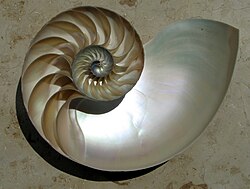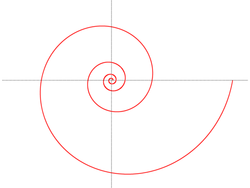Logarithmic spiral
 Cutaway of a nautilus shell showing the chambers arranged in an approximately logarithmic spiral |
 The arms of spiral galaxies often have the shape of a logarithmic spiral, here the Whirlpool Galaxy. |
A logarithmic spiral, equiangular spiral or growth spiral is a special kind of spiral curve which often appears in nature. The logarithmic spiral was first described by Descartes and later extensively investigated by Jakob Bernoulli, who called it Spira mirabilis, "the marvelous spiral".
Definition
In polar coordinates (r, θ) the curve can be written as
- [math]\displaystyle{ r = ae^{b\theta}\, }[/math]
or
- [math]\displaystyle{ \theta = \frac{1}{b} \ln(r/a), }[/math]
hence the name "logarithmic". In parametric form, the curve is
- [math]\displaystyle{ x(t) = r \cos(t) = ae^{bt} \cos(t)\, }[/math]
- [math]\displaystyle{ y(t) = r \sin(t) = ae^{bt} \sin(t)\, }[/math]
with real numbers a and b.
The spiral has the property that the angle ɸ between the tangent and radial line at the point (r,θ) is constant. This property can be expressed in differential geometric terms as
- [math]\displaystyle{ \arccos \frac{\langle \mathbf{r}(\theta), \mathbf{r}'(\theta) \rangle}{\|\mathbf{r}(\theta)\|\|\mathbf{r}'(\theta)\|} = \arctan \frac{1}{b} = \phi, }[/math]
The derivative r'(θ) is proportional to the parameter b. In other words, it controls how "tightly" and in which direction the spiral spirals. In the extreme case that b = 0 (ɸ = π/2) the spiral becomes a circle of radius a. Conversely, in the limit that b approaches infinity (ɸ → 0) the spiral tends toward a straight line. The complement of ɸ is called the pitch.
Spira mirabilis and Jakob Bernoulli
Spira mirabilis, Latin for "miraculous spiral", is another name for the logarithmic spiral. While this curve had already been named by other mathematicians, the name "miraculous" or "marvelous" spiral was given to this curve by Jakob Bernoulli, because he was fascinated by one of its unique mathematical properties: the size of the spiral increases, but the shape stays the same with each added curve. Maybe because of this property, the spira mirabilis has evolved in nature, seen in some living beings, such as nautilus shells and sunflower heads. Jakob Bernoulli wanted the shape on his headstone, but, by error, an Archimedean spiral was placed there instead.
Logarithmic Spiral Media
A section of the Mandelbrot set following a logarithmic spiral
Cutaway of a nautilus shell showing the chambers arranged in an approximately logarithmic spiral. The plotted spiral (dashed blue curve) is based on growth rate parameter b = 0.1759, resulting in a pitch of \arctan b \approx 10^\circ.
Notes
The logarithmic spiral can be distinguished from the Archimedean spiral by the fact that the distances between the turnings of a logarithmic spiral increase in geometric progression, while in an Archimedean spiral these distances are constant.
Logarithmic spirals are self-similar in that they are self-congruent under all similarity transformations (scaling them gives the same result as rotating them). Scaling by a factor [math]\displaystyle{ b^{2 \pi} }[/math] gives the same as the original, without rotation. They are also congruent to their own involutes, evolutes, and the pedal curves based on their centers.
Starting at a point P and moving inwards along the spiral, one has to circle the origin infinitely often before reaching it; yet, the total distance covered on this path is finite. This was first realized by Evangelista Torricelli even before calculus had been invented. The total distance covered is r/cos(α), where r is the straight-line distance from P to the origin.
One can construct approximate logarithmic spirals with pitch about 17.03239 degrees using Fibonacci numbers or the golden ratio as is explained in those articles. Similarly, the exponential function exactly maps all lines not parallel with the real or imaginary axis in the complex plane, to all logarithmic spirals in the complex plane with centre at 0. (Up to adding integer multiples of 2πi to the lines, the mapping of all lines to all logarithmic spirals is onto.) The pitch angle of the logarithmic spiral is the angle between the line and the imaginary axis.
Logarithmic spirals in nature
In several natural phenomena one may find curves that are close to being logarithmic spirals. Here follows some examples and reasons:
- The approach of a hawk to its prey. Their sharpest view is at an angle to their direction of flight; this angle is the same as the spiral's pitch.
- The approach of an insect to a light source. They are used to having the light source at a constant angle to their flight path. Usually the sun is the only light source and flying that way will result in a practically straight line.
- The arms of spiral galaxies. Our own galaxy, the Milky Way, is believed to have four major spiral arms, each of which is roughly a logarithmic spiral with pitch of about 12 degrees, an unusually small pitch angle for a galaxy such as the Milky Way. In general, arms in spiral galaxies have pitch angles ranging from about 10 to 40 degrees.
- The arms of tropical cyclones, such as hurricanes.
- Many biological structures including spider webs and the shells of mollusks. In these cases, the reason is the following: Start with any irregularly shaped two-dimensional figure F0. Expand F0 by a certain factor to get F1, and place F1 next to F0, so that two sides touch. Now expand F1 by the same factor to get F2, and place it next to F1 as before. Repeating this will produce an approximate logarithmic spiral whose pitch is determined by the expansion factor and the angle with which the figures were placed next to each other. This is shown for polygonal figures in the accompanying graphic.
Related pages
References
- Eric W. Weisstein, Logarithmic Spiral at MathWorld.
- Jim Wilson, Equiangular Spiral (or Logarithmic Spiral) and Its Related Curves Archived 2021-05-01 at the Wayback Machine, University of Georgia (1999)
- Alexander Bogomolny, Spira Mirabilis - Wonderful Spiral, at cut-the-knot
Other websites
- Spira mirabilis Archived 2007-07-15 at the Wayback Machine history and math








